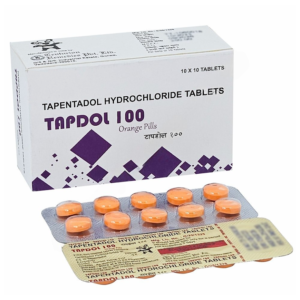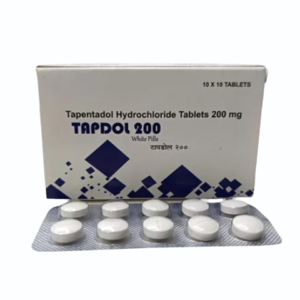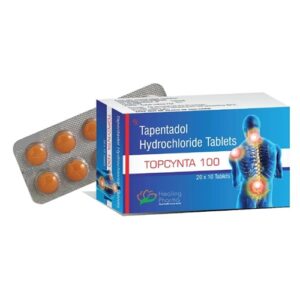Pain Killers
Showing 31–33 of 33 results
-

Tapdol 100 mg Tablets
$125.00 – $485.00Select options This product has multiple variants. The options may be chosen on the product page -

Tapdol 200 mg Tablets
$155.00 – $395.00Select options This product has multiple variants. The options may be chosen on the product page -

Topcynta 100 mg Tablets
$125.00 – $485.00Select options This product has multiple variants. The options may be chosen on the product page
Pain is a protective body mechanism to resist impulses. Actual and potential tissue damage can result in a painful sensory experience. The sensation occurs due to a mix of physiological and psychological reactions. The sensation is directly connected with injury or the fear of injury. The intensity of feeling varies from person to person. People feel pain on different levels, depending on their tolerance, and describe it based on their subjective feelings and experiences. Social, cultural, cognitive, psychological, and genetic factors may influence responses and reactions to pain.
You feel pain when you suffer from body injuries. The affected body parts send pain signals to the brain through neurotransmitters. Nociceptors (specific nerves) can detect tissue damage and convey the message to the brain. As a consequence, a reflex occurs even before the brain receives the signal. Once the pain signal reaches the brain, an individual feels an unpleasant sensation.
The brain releases happy hormones to counter the painful sensation. Several potent pain-relieving medicines are available on the market to help soothe the pain. Upon intake of effective painkillers, the person in pain can experience a sense of relief.
Which Factors Are Responsible for Pain?
Each kind of pain is biopsychosocial. Biological, psychological, and social factors interact to decrease the painful sensation in the body. Individuals’ responses to pain are always different. According to Hippocrates, the Greek Physician, one feels pain when any of the four substances of blood, phlegm, yellow bile, and white bile spikes or falls way beyond the normalcy level.
What are the core elements of the three factors that stimulate pain?
Biological: Age, gene, system dysfunction, damaged tissue, inflammation, diet, water intake, sleep routine, anatomical and biomechanical concerns, etc.
Psychological: Emotions, memories, beliefs, thoughts, evaluative capacity, attentional and executive processes, coping mechanisms, etc.
Sociological: Access to care and attention, socioeconomic status, family comfort, home ambience, race, culture, ethnicity, society, context, environmental conditions, etc.
Expert doctors administer a potent pain relief treatment with a multidisciplinary approach that works on the body, brain, and psychology of the person with pain. The essential remedies include medicines, physical therapy, occupational therapy, and other modalities.
What Factors Influence the Intensity of Pain?
When you receive a blow or an injury, your body sends a pain signal down the spinal cord, resulting in automatic muscle contraction. In extreme cases, the reflex is so fast that the message does not reach the brain. Once the body feels the blow, the messages reach the brain in seconds.
The intensity of the pain is determined by how the brain receives the pain signals and how clearly it communicates with the nociceptors. After receiving the signals, the brain instantly releases feel-good hormones like Dopamine to soothe the discomfort and unpleasantness.
Many factors may influence how and why individuals feel pain with different intensities. According to studies and research, psychological ( mental and emotional health, mood, fear and avoidance, concept of pain, pain resilience), biological (nervous system, immune system, genetics and epigenetics of pain, and the endocrine system), and social reasons may influence an individual’s experience of pain. This is why pain is also known as a biopsychosocial experience. Each set of factors interacts with one another in the body. Hence, the pain treatment is both complex and subjective.
What Are the Types of Pain and How Do They Work?
Pain is of two types – Acute and Chronic.
What is Acute Pain?
Acute pain is generally short-lived and intense. It signals the body about tissue damage or an internal injury. Simply treating the injury can eliminate the acute pain. This kind of pain results in faster heartbeats, and the body goes into fight-or-flight mode while suffering from it.
Acute pain is intense but does not last long. It conveys the message to the brain of tissue damage or an internal injury. Quick, effective treatment can reduce acute pain. Individuals with acute pain may feel faster heartbeats. In such cases, the body chooses either the fight or the flight mode when hit by acute pain.
Acute pain can be of various types –
Somatic pain: The pain feels on the skin or the soft tissues just below the skin. The pain is a superficial one.
Visceral pain: One can feel the pain in the internal organs and the cavity linings of the body.
Referred pain: When one experiences visceral pain in places other than the damaged areas. For instance, when a person suffers cardiac arrest, their hands and shoulders also feel intense pain. This is known as referred pain.
What is Chronic Pain?
Chronic pain lasts a long time and feels more intense than acute pain. It can be mild to severe. Chronic pain has no cure. Arthritis or migraine attacks can cause this kind of pain. A person with chronic pain may suffer a blow at frequent intervals.
In chronic pain, the sympathetic nervous system adapts to the pain stimulus. As a result, the person with an injury or chronic illness experiences the pain long after the event.
Other types of pain include –
Neuropathic Pain
A person suffers from neuropathic pain when the peripheral nerves are injured. These nerves directly connect the brain and spinal cord to the body. The pain shows the symptoms of numbness, electric shock, and tingling sensations.
Central Pain
Central pain may occur due to tumors, infarctions, abscesses, or internal bleeding in the brain and spinal cord. It can be mild to severe and constantly disrupt one’s life. People who suffer from central pain feel pressing or burning sensations.
Phantom Pain
Amputation is the primary cause of phantom pain. The painful sensation comes from the pain of a missing limb.
It’s crucial to describe the pain the right way to the doctor for an accurate diagnosis.
How to Identify Pain?
When one suffers pain, the interpretation is entirely personal. A doctor diagnoses the pain based on the patient’s description of the pain. No fixed parameter or scale can help the doctor measure or diagnose the pain. The doctor may ask for the patient’s pain history for a more accurate diagnosis. The doctor must know the information below –
- How is the nature of pain – stinging, burning, or stabbing?
- How intense is the pain? When a person feels the pain, how severe it feels, and how the pain spreads.
- What makes the pain feel worse? What feels soothing to relieve the pain?
- When does the pain feel the most in a day?
- How does the pain affect the person’s emotional health and daily life?
- How does the person understand the pain? What are the sources?
Doctors consider various factors to detect and measure pain. Clear communication between the doctor and the patient makes the entire process easier and helps diagnose the pain accurately.
What Are the Key Indicators of Pain?
Apparent indicators always accompany pain. One with pain goes through a phase while dealing with the hints the body shows. Doctors need to know the indicators to understand the severity of the pain. For instance, people with cognitive disability cannot describe the pain correctly, but clear indicators help identify and scale the pain. The indicators are as follows,
- Crying & Groaning
- Restlessness
- Resistance to care
- Reluctance in social interactions
- Clueless thoughts
- Lack of appetite
- Sleep disorder
The doctor treats the root causes of pain while checking the indication. If the condition is treatable, the doctor prescribes potent painkillers or other treatment therapies to reduce and eliminate the pain.
Potent Pain Relief Treatment and Medication
Remember, pain is a protective mechanism that stops impulses and is directly linked with body injuries or fear of injury. Pain resistance in humans occurs on different levels based on several factors. As discussed earlier, social, cultural, psychological, genetic, and cognitive factors influence the depth of the pain. For example, a bodybuilder or sports person can tolerate pain more than others. At Meds Magic, you can get the best quality painkillers at the best price under your doctor’s prescription. Order potent medicines like Aspadol 100, Pregabalin Capsules, Gabapentin Tablets, SOMA (Carisoprodol) 500 MG TABLETS, and Tapentadol Tablets across the USA with fast shipping processes with Meds Magic. A wide array of non-medical methods is also available to relieve pain. The alternatives include acupuncture, nerve blocks, relaxation techniques, psychotherapy, physical manipulation, biofeedback, heat and cold compresses, etc.
Disclaimer
Meds Magic intends to ensure that consumers receive accurate and authentic medicine-related information. The information provided here is not a substitute for the advice of a qualified doctor. The information you receive here is provided for informational purposes only. The content may not cover all information about specific health conditions, medicines, diagnostic tests, drug interactions, precautions, warnings, and all potential side effects. It’s always advisable to talk to your doctor and discuss your queries on any health condition or medicine. Our objective is to keep you updated, not to replace the doctor-patient equation.
Handpicked for their reliability and effectiveness.
Find Exactly What You Need, Quickly and Easily
Home Health Care
Home Health Care
Home Health Care

